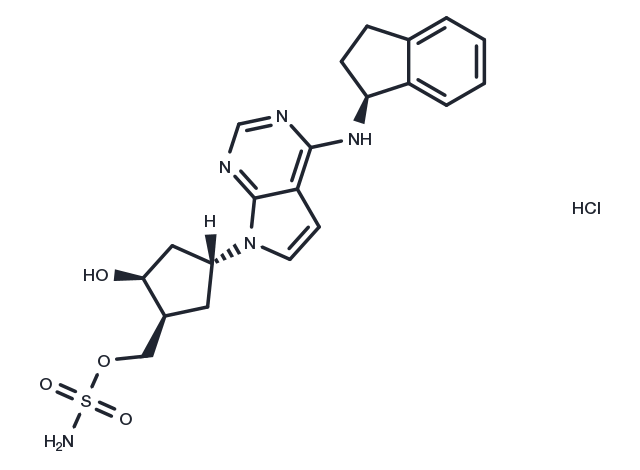Powder: -20°C for 3 years | In solvent: -80°C for 1 year


Pevonedistat hydrochloride is an effective and selective inhibitor of NEDD8-activating enzyme (IC50: 4.7 nM).

| Pack Size | Availability | Price/USD | Quantity |
|---|---|---|---|
| 2 mg | 5 days | $ 65.00 |
| Description | Pevonedistat hydrochloride is an effective and selective inhibitor of NEDD8-activating enzyme (IC50: 4.7 nM). |
| Targets&IC50 | NAE:4.7 nM |
| In vitro | Pevonedistat is an effective inhibitor of NAE (half-maximal inhibitory concentration (IC50=0.004 μM), and is selective relative to the closely related enzymes UAE, SAE, UBA6 and ATG7 (IC50=1.5, 8.2, 1.8 and >10 μM, respectively). Pevonedistat (MLN4924) rapidly inhibits cullin 1 neddylation and remarkably suppressed growth and survival as well as migration in a dose-and time-dependent manner in gastric cancer cells, and significantly suppresses migration by transcriptionally activating E-cadherin and repressing MMP-9. Pevonedistat induces CLL cell apoptosis and circumvented stroma-mediated resistance. Pevonedistat promotes induction of Bim and Noxa in the CLL cells leading to rebalancing of Bcl-2 family members toward the proapoptotic BH3-only proteins. Pevonedistat treatment inhibits overall protein turnover in cultured HCT-116 cells. Treatment of HCT-116 cells with Pevonedistat for 24 h causes a dose-dependent decrease of Ubc12-NEDD8 thioester and NEDD8-cullin conjugates (IC50 < 0.1 μM) resulting in a reciprocal increase in the abundance of the known CRL substrates CDT1, p27 and NRF2 (also known as NFE2L2), but not non-CRL substrates[1][2][3]. |
| In vivo | Pevonedistat administered on a BID schedule at 30 and 60 mg/kg inhibits tumor growth (T/C: 0.36 and 0.15, respectively). Pevonedistat (30 or 60 mg/kg, s.c.) causes a dose- and time-dependent enhance the steady-state levels of NRF2 and CDT1 in HCT-116 tumor-bearing mice and reduces NEDD8-cullin levels in normal mouse tissue as illustrated in mouse bone marrow cells [1]. |
| Synonyms | MLN4924 hydrochloride |
| Molecular Weight | 479.98 |
| Formula | C21H26ClN5O4S |
| CAS No. | 1160295-21-5 |
Powder: -20°C for 3 years | In solvent: -80°C for 1 year
DMSO: 100 mg/mL (208.34 mM), Sonication is recommended.
H2O: 10 mg/mL (20.83 mM), Sonication is recommended.
You can also refer to dose conversion for different animals. More
bottom
Please see Inhibitor Handling Instructions for more frequently ask questions. Topics include: how to prepare stock solutions, how to store products, and cautions on cell-based assays & animal experiments, etc.
Pevonedistat hydrochloride 1160295-21-5 Others Pevonedistat Hydrochloride MLN4924 hydrochloride MLN 4924 Hydrochloride MLN-4924 Hydrochloride MLN4924 Hydrochloride inhibitor inhibit
